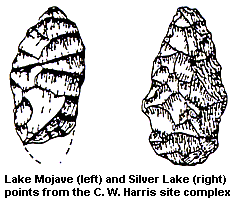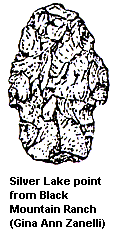Lake Mojave and Silver Lake Points
Lake Mojave and Silver Lake projectile points have been reported from pre-Archaic contexts (ca. 9000-6000 B.C.) in the Desert West and elsewhere in California (cf. Justice 2002; Moratto 1984). Some observers have felt that the points are also present in later (Pinto Complex) contexts (Harrington 1957; Lanning 1963; Warren and Crabtree 1986), while others have considered the point forms to be chronologically diagnostic of very early Holocene (Paleoindian) occupations (cf. Jennings 1986). The rare Lake Mojave and Silver Lake points from San Diego sites have generally been interpreted as reflecting an early occupation, with cultural links to the Desert West.
 The Lake Mojave point type was defined by Charles Avery Amsden on the basis of specimens recovered in the eastern Mojave Desert (Campbell et al. 1937:80-81). Lake Mojave points generally have straight or convex, strongly diverging blade sides; weak shouldering; and gently tapering stems that are longer than the distal (blade) portions of the points. Claude N. Warren and D. L. True (1961:252; Warren 1967:173) recovered a Lake Mojave point from the San Dieguito component at the C. W. Harris Site Complex near Rancho Santa Fe (SDI-149/316).
The Lake Mojave point type was defined by Charles Avery Amsden on the basis of specimens recovered in the eastern Mojave Desert (Campbell et al. 1937:80-81). Lake Mojave points generally have straight or convex, strongly diverging blade sides; weak shouldering; and gently tapering stems that are longer than the distal (blade) portions of the points. Claude N. Warren and D. L. True (1961:252; Warren 1967:173) recovered a Lake Mojave point from the San Dieguito component at the C. W. Harris Site Complex near Rancho Santa Fe (SDI-149/316).
The Silver Lake point type was defined by Elizabeth N. Crozer Campbell (1936; Campbell et al. 1937), also on the basis of Mojave Desert specimens. These points have straight to convex, strongly diverging blade sides; stronger shouldering than Lake Mojave points; and shorter stems that may be straight, contracting, or expanding. Several specimens interpreted as Silver Lake Points have been reported from San Diego County sites:
- A single Silver Lake point was recovered by Richard L. Carrico, Theodore G. Cooley, and Joyce M. Clevenger (1990) from the surface of SDI-319B, another portion of the C. W. Harris Site Complex. The material from which this specimen was manufactured was not identified, but was considered to be probably nonlocal in origin.
- At SDI-5103, not far from the C. W. Harris Site Complex, Brian Glenn (1992) reported recovering a projectile point base that was “typologically similar to the desert Silver Lake style.”

- At the Windsong Shores Site (SDI-10,965) in Carlsbad, Dennis R. Gallegos (1991:26; Gallegos and Carrico 1984) recovered one basalt point that was classified as a Silver Lake form. The excavation level in which the point was found also yielded a radiocarbon date, based on Chione shell, of 8060 ±90 years B.P. (ca. 6500-6000 B.C.).
- Dennis H. O’Neil (1982:62, 64, 120) reported recovering four “Type 10” projectile points at site SDM-W-1556 in San Marcos. O’Neil’s Type 10 points were considered “somewhat reminiscent of the Silver Lake type stemmed points”.
- Michael S. Forstadt, Tirzo Gonzalez, Jerry W. Forstadt, and Stanley R. Berryman (1992) recovered a complete Silver Lake point, apparently made from local basalt, at site SDI-11,983 on Black Mountain Ranch.
PROSPECTS
Future archaeological investigations may be able to determine more precisely the chronological ranges for the occurrence of Lake Mojave and Silver Lake points in San Diego sites. Research strategies for resolving these issues may include developing more rigorous definitions of the point types, collecting radiocarbon dates associated with such points, measuring hydration on any obsidian specimens, identifying the probable geological sources of the materials used for the points, and assessing their manufacturing techniques, evidence of rejuvenation, use wear, use residues, and relative patination.